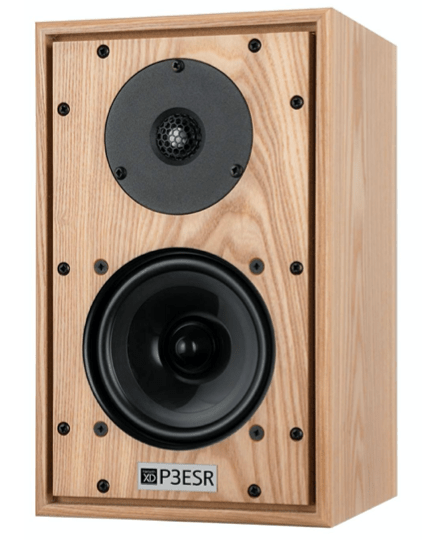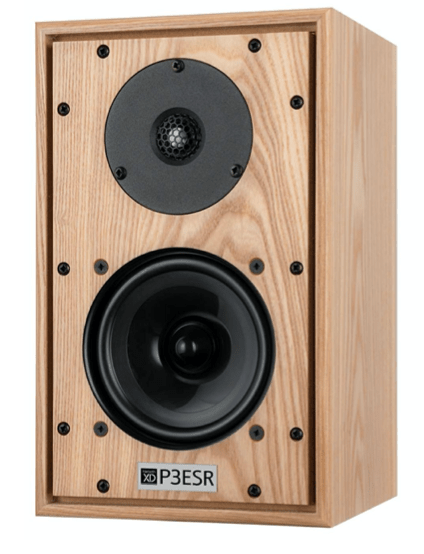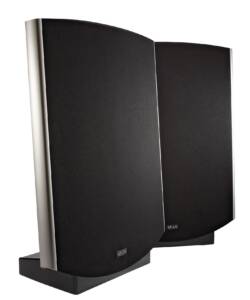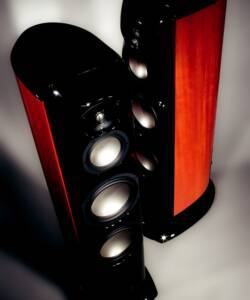Harbeth P2ESR SE Bookshelf Speakers
Original price was: R62,000.00.R29,000.00Current price is: R29,000.00.
If it ain’t broken, don’t fix it.
A change is as good as a rest.
Many hands make light work.
Too many cooks spoil the broth.
Conventional wisdom is chock full of contradictions. So, who – or what – to believe?
Never meet your heroes – they’ll only disappoint. That’s what conventional wisdom tell us. The Harbeth P3ESR is a standmount loudpseaker that (almost) never comes up for sale on the second market down under. One that – on the basis of prior Harbeth exposure – I had begun to fete from afar. I’d never heard a pair of Harbeths I didn’t like. Friends own SHL-5 and C7ES3, which I always enjoy when I make social calls to their respective owners – that thick midrange is unique and unmistakable.
Furthermore, I spent a few weeks with the C7ES2 standmount in mid-2010. They had some magic going on. The Pixies’ Doolittle – an 80s master that sounded thin and uninviting on every other loudspeaker – was rendered as warm and engaging. The C7ES2 made everything sound so darn listenable, albeit with an unmistakable oven-baked quality. Were they a touch coloured? Yes sir. Did I care? Not in the slightest. An enjoyable sound is an enjoyable sound.
Harbeth has no official distributor in Australia. They sell direct to our shores with no middleman. I like this selling model. It has kept carping about local pricing of Harbeth loudspeakers out of “Why is Australia so expensive?” debate – surely everyinternational brand would prefer to be kept from those consumer-driven thumbscrews?. A pair of the most junior Harbeths – the P3ESR – can be landed to your doorstep for ~AU$2500. This review pair come marked as “Special Edition – Studio Grade Ultra Pure OFC Cable” – the internal wiring has seen a recent update.
The speaker boxes themselves are finished to a level that is nothing short of exemplary. Facing facts: they look stunning and they’re re-assuring weighty to hold. Being sealed boxes, the P3ESR are already off to a flying start. I enjoy the tighter/leaner bass of sealed designs more that ported variants – a personal preference but one that you should be aware of. Reagan-like trickle-down has seen Alan Shaw deploy his trademarked RADIAL mid/bass driver technology in even his smallest mini monitor. This one’s a five incher.
The P3ESR have that ProAc-like top-end zing. Plenty of room air, plenty of zig-a-zig-aaaaah! Not as smooth or as refined as the Proac 1SC (discontinued) or as humid as the Spendor SA1 (AU$2700) – they sit somewhere between the two. There’s more up-ending in favour of the upper-mid band; ideal for Radiohead’s King Of Limbs vocal tension – an album that snakes through midrange grass. Thom Yorke’s mellifluous delivery demands the vocal clarity that the P3ESR bring in spades. They’re an open window on vocal and rattling percussion, on rhythm guitar wriggle and – especially – on horn sections. The King Of Limbs‘ most fragile/tender moment – “Give Up The Ghost” – is a standout, Yorke’s voice transmitted to the heavens. Witness treble extension that captures recording space ambience. The 47Labs Lens pay it forward, the Harbeths work in an up-and-down world, closer to the speaker plane.
They’re not as IN YOUR FACE as the 47 Labs full-ranger, but not as fast either. Still, off-axis listening is a pleasure that sets the P3ESR listener free. This reviewer has little patience for those divisive head-in-a-vice devices. At lower volumes, it takes a bit more of a push to get the Harbeths out of bed and dressed for work. They’re also slightly more “hifi” sounding than the Lens – that is, one is more aware of listening to audio equipment than music. Genetically closer to the WLM Stella, one trades in the purity of the Lens for a more recognisable two-way loudspeaker transparency. The Harbeths offer superior body and instrument density to the Lens – deeper bass too – but don’t resolve the urgency of electronic music anyway near as well. The tundra-winds of Mike Denhert’s pathological Framework are blown too far south, where warmer weather patterns circulate. The Harbeths imbue proceedings with welcome-mat and hot chocolate where there should be only Nietzsche and the neutral-hearted mechanics of Godlessness. ATC SCM 11s do 909s and 303s with superior cleanliness. ATC 4 IDM.
With simpler fare – Bill Callahan’s brooding song-smithery – the Harbeths once again beam a torch down Callahan’s deep-well vocal delivery. Their midrange confessional is never in doubt, Callahan’s voice a decanter of liquor-infused melancholy. Misery runs deep down here. His simple supporting cast (acoustic bass and dry drum) is presented as full and tonally ripe. Most enjoyable.
Similar to the 47Labs in their plonk-em-down-and-plug-em-in simplicity, the P3ESR play nicely with even modestly powered amplifiers. They work in both small and larger rooms. Another high quality two-way for modern living spaces but with a strong leaning toward jazz and acoustic fans. They do rock – verb, not noun – but ever so politely. Pumping the juice assists greatly – the P3ESR need to be woken up with a power jolt. An amplifier of pure blood and guts will serve you well. Forget about a refined, mature amplifier. There’s enough of those golden years tendencies from these Brit transducers themselves so hook up a box that kicks serious arse. (No wonder Naim-nerds dig their Harbeths).
For my listening outings, the Heed Obelisk Si’s warm organics didn’t tick as many synergistic boxes as the feisty Dayens Ampino. The latter’s transistorised treble attack reshapes the Harbeth Chesterfield lounge with some much needed Philippe Starck (metallic) modernity, without which we return to images of smokey old men perusing broadsheets in the thickening afternoon gloom of a gentlemen’s club. The very budget-friendly REDGUM integrated proved to be the most engaging Harbeth partner – plenty of punch and dynamics, as well as some much-needed transient attack.
The BBC heritage heard in the P3ESR is the corporation responsible for epic costume dramas, The Antiques Roadshow and Last of The Summer Wine. All middle-class, middle-of-the-road fare. Not that the P3ESR are ultra MOR, but they do tend toward quite a conservative sonic disposition. Is it derisory to suggest that the target market for these boxes may align significantly with the target audience of Sunday night BBC 1?
Speakers for gentlemen of advancing years – smooth and refined. The sound of post-war austerity. Speakers to retire with, to drift into old age with. Pipe and slippers. Leather arm chair. They’re so smooth, so refined. Think David Niven or Terry Wogan. They take themselves seriously. Think: no sex please, we’re British.
So I ask: where’s the excitement, fellas? “Oh you don’t want that – it’ll tire you out. Time for a nice cup of tea and an afternoon nap…”.
Perhaps it’s the unattainable expectations that I brought to these boxes? Perhaps my amplification choices weren’t up to muster? If so, it’s the sound of irony knocking given Shaw’s off-hand dismissal of the need for more esoteric power.
Perhaps my choice of music not sufficiently ‘audiophile’? Whatever. The Harbeth P3ESR and I didn’t fuse with magic and wonderment (as I thought we might). What I thought might be a stunning little loudspeaker materialised as (merely) a very good one when placed in the context of 47Labs’ Lens and (to a lesser extent, but still noticeable) the WLM Stella. The P3ESR’s major drawback is that it wants to constantly remind you how very accomplished – how very well read – it is. A loudspeaker almost too immodest to stand aside and let the music do the talking. A loudspeaker far better with soothing, intimate portraiture than the tumult of electric(ronic) storm landscapes or abstract expressionism.
Never meet your heroes. Damn straight. I don a pair of awkward trousers to conclude that whilst these are a super little standmount, I didn’t attain the expected jaw-drop awe; particularly with more complex (electronic) music. The competition has set a high bar. The twenty year-old Rogers LS4a might not be as resolving but they are more fun, more comfortable in their own skin, not as uptight. They are more willing to get out of their comfort zone. The Harbeths are more stubborn in this regard. They know what they like and they like what they know: jazz, vocal, acoustic. Angus and Julia Stone fans will hit pay dirt.
For such (lighter) music genres there is probably no better standmount in this price bracket – probably why there are plenty of folk who adore the Harbeth mini monitors. However, I doubt any of them are AFX freaks or Hawtin heads. Push the P3ESR into overtly furious or complex music and they fall just shy of satisfactory (it ain’t the lack of bass, it’s the lack of speed).
This review should read as a second opinion that transposes a pre-existing, near-unanimous and overwhelmingly positive diagnosis. Mine is an opinion of the Harbeth P3ESR in the context of more esoteric musical fodder. Or, an opinion to be dismissed out of hand! I can live with that. Different strokes for different folks. Or is variety the spice of life?
Harbeth’s P3ESR is a British standmount with an unashamedly ‘classic’ sound, sure to transport lovers of jazz and vocal to new heights.
Everyone wants something different from a loudspeaker. Some people value midrange neutrality above all, while others will sacrifice some of that accuracy to get extended lows or a speaker that will play immensely loud with only a few watts of power. Some want stereo imaging that is sufficiently delicate, stable, and accurate that the speakers open a transparent window on the recording’s original performing space. Some will sacrifice all of the above to get a speaker whose “jump factor” can jerk zombies out of their stupor. And there are those who are prepared to lose just a little bit of everything in order to have a speaker that may not excel in any of these areas, but communicates what they want from their music in the most effective overall manner.
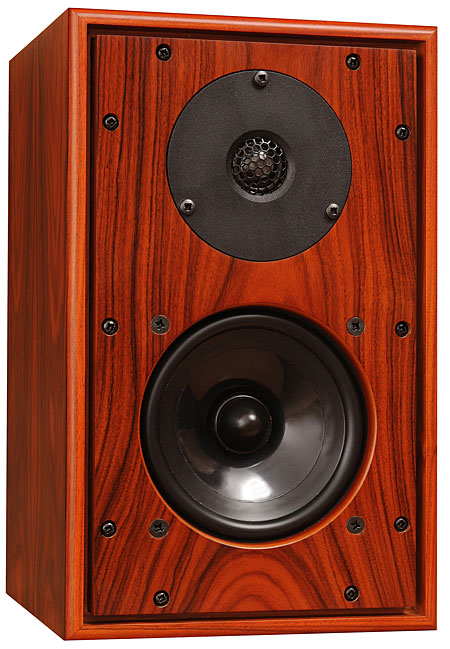
Ultimately, of course, and provided that you a) have very deep pockets and b) are prepared to reach to the very bottom of those pockets, you can have everything. But each of us who lives in the real world of car payments, mortgages, and college-age children must decide what is most important to us. You can’t, therefore, say that real-world speakers with more extended lows are inherently better than those that excel at soundstaging, or that both are inferior to those with zero midrange coloration. All that can be said is that one of those choices will fit your needs better than it fits others’ needs. That’s why so many companies offer so many different speaker models at so many prices.
Which brings me to Harbeth’s P3ESR. At just 12″ tall, this is not a speaker that will succeed at playing pipe-organ recordings. And with a single woofer just 5″ in diameter, it’s not going to play super-loud or fill large rooms with sound. But because the earlier versions of this sealed-box, two-way minimonitor excelled at reproducing the all-important midrange, and were champs at re-creating a believable soundstage, I have patiently awaited review samples ever since I auditioned an early prototype at the 2009 Consumer Electronics Show.
The original HL-P3 was designed by Harbeth’s Alan Shaw to replace the venerable BBC LS3/5A location monitor, of which Harbeth had been a licensee. (For the full history of this classic design, click here.) I reviewed the HL-P3 in December 1993; John Marks enthused over the ES-2 version in the October 2005 installment of his column, “The Fifth Element,” and I followed with a full review in April 2007. (You can find all this coverage, which includes the full backgrounds of both the design and Harbeth Audio Ltd., starting here.)
The fundamental design of the P3ESR remains unchanged from its predecessor: a 0.75″ (19mm) ferrofluid-cooled aluminum-dome tweeter, protected by a mesh screen (in this version, black instead of gold), is coupled to a 5″ plastic-cone woofer, mounted on the front baffle from behind. The baffle is veneered, and the cutout for the woofer has radiused edges. The woofer (made in the UK according to its label) is constructed on a diecast chassis, and at the end of its pole-piece has a half-roll rubber surround and a moving dustcap rather than the currently fashionable stationary phase plug. The crossover is complex, with five inductors, ten capacitors, and three resistors.
The new speaker has a single pair of gold-plated terminal posts on its rear panel, compared with the earlier version’s two pairs, for biwiring. The most important change is the use of Harbeth’s proprietary and patented Radial2 material for the woofer cone. Used by Harbeth in its more expensive designs, Radial2 is said to be a thermally stable, low-mass, low–energy-storage composite polymer that offers more clarity and better low-level resolution than polypropylene.
The 1993 version of the ‘P3 sold for $1199/pair; in 2007, 14 years of inflation later, the price of the ‘P3ES-2 was $1850–$2150/pair. Now, in 2010, the P3ESR costs $2195–$2395/pair, depending on the finish chosen. This might be thought expensive for a minimonitor, but I don’t think it unreasonable for such a beautifully finished, high-performance speaker manufactured in a high-wage country. As Michael Fremer’s mother used to say, “You pay, you get.”
Listening
I set up the P3ESRs on 24″-tall Celestion stands, the latters’ center pillars filled with dry sand and bird shot. The speakers were toed-in to the listening position and placed well away from room boundaries, and I did quite a lot of experimenting with position to get the transition from the upper bass through the midrange balanced as smoothly as possible. Harbeth recommends that the P3ESR be used with its grille in place. This consists of black cloth stretched over a thin metal frame that fits into a rectangular slot around the edge of the front baffle. With the grille in place, there is thus no additional acoustic obstruction anywhere near the drive-units. However, I felt the balance was a little too smooth with the grilles, and did most of my listening without them.
The three speakers that preceded the little Harbeths in my listening room were all large, expensive, full-range floorstanders: the Revel Ultima Salon2 ($22,000/pair, reviewed in June 2008), the Aerial Acoustics 20T V2 ($32,000/pair, reviewed in November 2009), and the Focal Maestro Utopia ($49,995/pair, reviewed in July 2010). When I began my auditioning of the P3ESRs, I expected to be made well aware of what I was giving up in quantity of sound.
Well, yes. Low bass was missing in action, as was most of the midbass. Listening to the low-frequency warble tones on Editor’s Choice (CD, Stereophile STPH016-2), there was useful bass output down to the 63Hz band, but not much of anything below that. And the speakers were obviously compressing the sound when I asked them to go louder than about 100dB. But having said that, what surprised me about the little Harbeths was how little I missed what the big speakers had been giving me.
Of course, the adage that your choice of loudspeaker dictates your choice of music still applies. What you tend to choose from your collection to play through a specific speaker will be those recordings that bring out that speaker’s best and hide its shortcomings.
Rather than reaching for Mahler symphonies, I found myself listening to recordings of small numbers of instruments and with a fairly restricted dynamic range—such as our December 2009 “Recording of the Month,” Anouar Brahem’s The Astounding Eyes of Rita (CD, ECM 2075). Even so, the grumbly bottom-octave notes of the double bass in the middle of the slow movement of Brahms’ Symphony 4, in the recording by Carlos Kleiber and the Vienna Philharmonic (SACD, Deutsche Grammophon/Esoteric ESSG90018) were satisfyingly audible, if somewhat miniature in scale. Similarly, while the softly struck bass drum in the title track of Daniel Lanois’s Shine (CD, Anti- 86661-2) didn’t have its full weight, the Harbeths reproduced enough of it to carry the musical load. The opener on Shine, “I Love You,” with Emmylou Harris, begins with a synth bass line that rocks between two notes an octave apart. While these notes weren’t as well differentiated as they are with full-range speakers, they still had a sufficiently satisfying “phat” quality through the Harbeth, even if the distinction between the octaves was a little blurred.
In this respect the P3ESRs benefited from the tighter low-frequency control of the Classé CTM-600 monoblocks, the Simaudio Moon Evolution W-7 sounding less well defined. But the Harbeth’s upper bass retained its definition even with the tubed Balanced Audio Technology VK-55SE. By comparison, my 1978 pair of original Rogers LS3/5As sounded overripe even with the Classés. Those vintage speakers also sounded significantly more nasal in the upper mids, and more spitty and coarse-grained in the treble than the Harbeths. My review samples of the earlier HL-P3ES-2 have long since been returned to the distributor, but I did note in my 2007 review that that model’s presence region was “a touch exaggerated, and its lower midrange was not quite as transparent as it was at higher frequencies.”
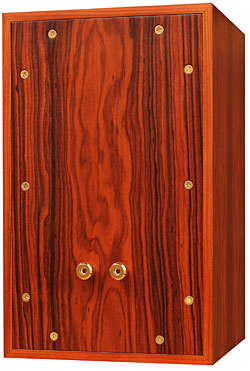 I didn’t get that impression with this new Harbeth. Even without the grille, the highs were smoothly balanced, with no region sticking out. The balance was a touch on the warm side, but without any obvious midrange coloration; both the male voices on my 2008 Cantus recording, While You Are Alive (CD, Cantus CTS-1208), and Mary Chapin Carpenter’s contralto on her new album, The Age of Miracles (CD, Zoë 01143-01133-2PE), sounded superbly natural. And the characters of the bass clarinet and bass guitar, when the two instruments were played in similar registers, were well differentiated on The Astounding Eyes of Rita.
I didn’t get that impression with this new Harbeth. Even without the grille, the highs were smoothly balanced, with no region sticking out. The balance was a touch on the warm side, but without any obvious midrange coloration; both the male voices on my 2008 Cantus recording, While You Are Alive (CD, Cantus CTS-1208), and Mary Chapin Carpenter’s contralto on her new album, The Age of Miracles (CD, Zoë 01143-01133-2PE), sounded superbly natural. And the characters of the bass clarinet and bass guitar, when the two instruments were played in similar registers, were well differentiated on The Astounding Eyes of Rita.
Stereo imaging was stable and accurate. Ysaÿe-Kreisler-Bach, Arturo Delmoni’s 1989 excursion into music for unaccompanied violin (John Marks JMR14, available as a premium gold CD from our e-commerce page), was reproduced with the violin placed within a warm, supportive, expansive acoustic. Changing from the solid-state Simaudio W-7 to the tubed BAT VK-55SE amplifier gave even more space behind and around the violin, but the top octaves now tilted up a little, which actually worked better with naturally made recordings such as this.
The obvious rival to the Harbeth is the almost identically sized and priced Spendor SA1, which I reviewed in August 2009. I no longer had these speakers to hand, but from my listening notes I would venture that they are somewhat more mellow-balanced than the Harbeths, within a similar performance envelope. The SA1’s low frequencies also had a little less weight. A system that is somewhat on the bright side, or that doesn’t allow the speakers to be placed well away from room boundaries, might work better with the Spendor.
I used my high-priced reference system for much of the preliminary auditioning of the Harbeths—it’s important, when introducing something new, to change no other components. But eventually, when I’d gotten a handle on the P3ESR’s balance, I switched to a more real-world rig. This comprised Peachtree’s iDecco 50Wpc integrated amplifier ($999; review underway) hooked up to the speakers with Cardas Neutral Reference cables, and with my 160GB iPod Classic sitting in its dock.
This is the system I’m listening to as I write this review, with Richie Havens performing The Who’s “Won’t Get Fooled Again” in his inimitable fashion, via an Apple Lossless file ripped from his Nobody Left to Crown (CD, Verve Forecast B0011631-02). Yes, indeed! Haven’s slightly lispy delivery, frantic, bar-chorded strumming, and the obbligato cello are all reproduced in full measure, forcing home the point of Pete Townsend’s lyrics. Harbeth’s P3ESR is one those speakers that gets the overall balance of what it does very right. If this system were to be placed behind an acoustically transparent curtain, few who heard it would believe that they were listening to a system costing less than $5000, or to speakers as small as these. Those listeners definitely would get fooled again—and to the benefit of their enjoyment of their music collections.
Oops
Saturn must be ascendant or something: Of late, Stereophile has had reliability problems with several review samples, and the Harbeth was no exception. Toward the end of the review period, I was giving the speaker a workout with some high-level rock when the soundstage lurched to the right and the balance became bright and brassy. “What the . . . ?”
I turned down the volume, checked all the wiring, and played the track again. All was again as it should be. Again I turned the volume up, and again it all went wrong. “What the . . . ?”
I remeasured the quasi-anechoic response of both samples on their tweeter axes. At continuous levels below about 7V RMS (equivalent to 8W into the Harbeth’s 6 ohm impedance), the responses of both speakers were the same as they’d been when I’d performed the formal measurements. But at sustained levels above that, the right-hand speaker (serial no. 0472R) developed a severe peak in its low-treble region. This peak disappeared when I backed off the level. I described this in an e-mail to John Marks, who had auditioned these samples before shipping them to me, but he had heard nothing such as this amiss with them.
All I could conclude was that, at the high power level, a crossover component had either opened or shorted, detuning the speaker’s balance. Reducing the level apparently brought things back to normal, both with listening and measuring, but this problem suggests that the crossover may be inadequately specified.
Summing up
The Harbeth P3ESR is one of those rare audio components that, within its obvious limitations, gives no other indication that it has been compromised. Yes, I did much of my auditioning with the budget-priced Peachtree iDecco integrated amplifier, but before the accident happened with the right speaker, I was using the Harbeths with the dCS Puccini SACD player and DAC ($22,000), the Simaudio Moon Evolution P-8 preamp ($12,000), and Classé CTM-600 monoblocks ($16,000/pair), all connected with expensive AudioQuest Wild cables. The P3ESRs did not sound outclassed in this system, merely restricted in loudness and bass extension.
I love the Harbeth P3ESR. I think it’s the best iteration yet from any manufacturer of the BBC LS3/5A minimonitor concept.
Description
Description:
Two-way, sealed-cabinet, stand-mounted loudspeaker.
Drive-units:
0.75″ (19mm) magnetically shielded, aluminum-dome tweeter;
5″ (110mm) magnetically shielded, Radial2-cone woofer.
Frequency response: 75Hz–20kHz, ±3dB.
Nominal impedance: 6 ohms (“easy to drive”).
Sensitivity: 83.5dB/2.83V/m.
Recommended amplification: >15W.
Power handling: 50W program.
Dimensions: 12″ (306mm) H by 7.5″ (189mm) W by 8″ (202mm) D, including grille and terminals. Weight: 14 lbs (6.3kg).





